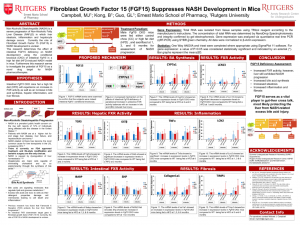Campbell, Michael: Fibroblast Growth Factor 15 (FGF15) Suppresses NASH Development in Mice
Title: Fibroblast Growth Factor 15 (FGF15) Suppresses NASH Development in Mice
Name: Michael Campbell
Major: Biotechnology
School affiliation: School of Environmental and Biological Sciences
Programs: Aresty – Research or Conference Funding Recipient
Other contributors: Bo Kong, Grace L. Guo
Abstract: Non-Alcoholic Steatohepatitis (NASH) is a severe progression of Non-Alcoholic Fatty Liver Disease (NAFLD) in which liver steatosis, inflammation and hepatocyte damage occurs. NASH is a prevalent public health concern on the rise with reports of 12% of individuals being affected with this disease in the United States. There are currently no treatments. Farnesoid X receptor (FXR), a nuclear receptor that is critical in regulating glucose and lipid metabolism homeostasis, is activated by bile acids. Previous research has found that FXR protects the liver from NASH progression. An intestinal FXR downstream target gene is fibroblast growth factor (FGF) 15/19. The role of FGF15 in NASH development is unclear. This current research determines the effect of intestinal FGF15 deficiency on NASH development using the conditional knockout (CKO) of intestinal FGF15 in a high fat diet (HFD)-induced NASH model in mice. Male Fgf15 CKO mice were fed either control chow or high fat diet, and sacrificed at 1, 3, and 6
months for assessment of NASH progression. Results suggest that FGF15 decreases bile acid synthesis, hepatic inflammation, and liver fibrosis. In conclusion, FGF15 serves a vital player in gut-liver cross talk, most likely protecting the liver from NASH-related excess bile acid injury. As the NASH global prevalence increases, therapeutic research for possible drug targets is of utmost importance.
